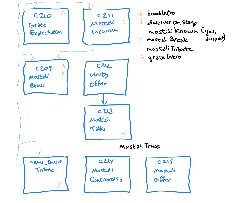Although people sometimes describe Six Ages (and its predecessor King of Dragon Pass) as “choose your own adventure” games, they are definitely not branching narratives. Choices do lead to other choices, but not along a predefined path.
Branching content can give the player a lot of choice, but even if you have only two choices for each decision, you can end up with a huge number of paths. And you’ll be creating content for pathways that will only rarely be visited. There are a variety of techniques creators use to deal with this. Six Ages and King of Dragon Pass address the problem by not turning their decisions into branches.
I’ve written (and spoken) before about how KoDP and Six Ages avoid the combinatorial explosion of branching by providing a political-economic framework to give your choices context and meaning. The narrative is broken into what we call “scenes” (they can also be called “floating modules” or “storylets”). Scenes are often picked at random, though with conditions to make sure they’re relevant or interesting. Typically they’re written to work in any situation. For example, a neighboring clan wants something from you. Whether they’re unfriendly or your allies makes a big difference, as does whether you can afford to pay what they ask (either in wealth or relations with other neighbors). Your response affects relationships (turning down a request has the potential to end an alliance), wealth, or internal politics (your own people have opinions too). This gives an implicit connection to the next scene (we lost a friend, we’re broke, people are grumpy, etc.). Essentially, most scenes connect to other ones—less directly than by branching, but more flexibly. And it’s easy to have more than two choices, to give players a wider range of action.
One way scenes connect seems rare in narrative games: a choice may trigger another scene at a later date. Plenty of story games have a time element (either by each choice advancing a clock, or treating time loosely and advancing the clock when conditions are met). The multi-generational scope of Six Ages means we can run a followup scene a year (or more) later, after ten player actions and another batch of scenes. For example, if you claim poverty, your neighbor may tell you they’ll be back next year. This is arguably a branch, since you made a choice and it leads to a repeat of the event. But intervening events may have changed the context, or invalidate the followup (for example, if a feud breaks out they won’t be back with a friendly request). It’s much more an emergent narrative than a branching story.

Six Ages does have scene sequences that are pretty close to a standard branching narrative. These tend to be a lot more complex for the QA team to test, since all the possible paths through the set need to be traversed. This is the chart that Jess made to track how a 6-scene sequence worked. The lines of flow are mostly implicit connections—choices in the second scene can impact your choices in the third or fourth scene, etc. They aren’t branches—in most cases, previous choices don’t preclude possible responses. But they’re distinct paths that provide context.
Our writer, Robin Laws, just finished writing another set of related scenes for Six Ages: Lights Going Out. I just finished coding them (into our OSL scripting language) today, so QA hasn’t had a shot at them. But I did my own chart to help with coding, and hopefully with testing. (This one just shows scene flow, not individual responses.)

Without the direct branching of “If you attack, turn to page 24,” sequences like this make use of state variables to keep track of what happened previously. This is hardly unique to Six Ages. All the scripting languages I’m familiar with let you do that. This sequence seemed particularly variable-heavy, however. I counted 25 variables that coordinate between 8 scenes. Some of this is for narrative continuity (what we learned and who we learned it from), tracking how often something has occurred (it may not be possible to do it again, or it may impact how easy a course of action is), which leaders were prominent in a previous scene, or magical effects. Not surprisingly, there’s an additional variable that can relate your decisions here to scenes that aren’t part of this set.
The goal of all this is to tell an interesting story that emerges from multiple player choices (not just story choices), unfolding after multiple game years. Almost as important, if you replay the game, you can make different choices for a different story—but even the same choices can give a different story, because the events can take place in a very different context.